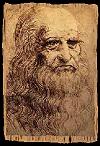|
Leonardo's notes contain many references to architecture, especially plans for cathedrals. His studies in this area commenced with the examination of various tools and instruments for building. This then progressed into an area never before studied, that of the varying strengths of pillars, beams, and arches.
Experts consider most of his studies on architecture were theoretical and Leonardo did not often face the practical problems caused by the act of construction. His notes on architecture are judged to be somewhat disappointing with titles like, "How to set up a framework for making decorations in the shape of a building." and "How to decorate a platform which has been erected for celebration." On the other hand, some sketches are particularly interesting as they are quite ambitious with enormous domes, chapels, four-way staircases, double spiral staircases, or multi-level thoroughfares for pedestrians and commercial traffic. All monuments that were never built. All plans destined never to be actioned. In his architectural work Leonardo went so far as to present a plan for the "ideal city" to Ludovico il More. This would have required the total rebuilding of Milan and, not surprisingly, nothing more ever came of it. Little ever came of Leonardo's drawings and plans in the area of architecture. He may have worked with Ambrogio da Cortis and Bramante, in 1492, on rebuilding the Vigevano marketplace and may also have been involved in two or three other civil improvement projects. Other than this, we know he submitted a model for the central tower of the Milan Cathedral. It was rejected on May 10th, 1490, and though Leonardo was invited to resubmit something different, he never finished his second model. Towards the end of his life Leonardo also worked on some sketches for the Queen Mother's castle at Romorantin. Again, these were never carried out.
An interest in mathematics was raised when Leonardo met up with Fra Luca Pacioli who introduced him to the delights of the topic, especially geometry. For a time the Italian mathematician moved in with Leonardo and he later illustrated Fra Luca Pacioli's book "On Divine Proportion". This new interest caused him to develop the idea, "There is no certainty where one cannot apply any of the mathematical sciences." Today this concept is universally accepted, but in Leonardo's time it was revolutionary thinking. |
|


